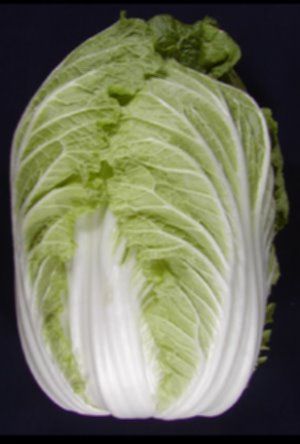Jan. 20, 2012 Research Highlight Biology
Unraveling the Chinese cabbage genome
The draft genome of the Chinese cabbage could underpin genetic improvement of brassica vegetable and oil crops
 Figure 1: The Chinese cabbage, Brassica rapa subspecies pekinensis. © 2011 Hiroshi Abe
Figure 1: The Chinese cabbage, Brassica rapa subspecies pekinensis. © 2011 Hiroshi Abe
Clues into the evolutionary diversification of brassicas have emerged from the draft Chinese cabbage genome sequence1. Brassica crops include many agriculturally important vegetables, such as Chinese cabbage, pak choi, turnip, broccoli, cabbage and cauliflower, as well as various oilseed crops.
The sequencing focused on Chinese cabbage, Brassica rapa subspecies pekinensis (Fig. 1), and was undertaken by the international Brassica rapa Genome Sequencing Project Consortium. The work was underpinned by the previously published genome sequence of the premier model of flowering plants, Arabidopsis thaliana. This species is related to B. rapa, with which it shared a common ancestor.
“Brassicas come in many shapes and sizes, and even individual species show considerable morphological variation. Genome information helps us understand the genetic basis of this diversity,” explains consortium member Hiroshi Abe of Japan’s RIKEN BioResource Center, one of the three biggest Arabidopsis stock centers in the world. “We developed genomic resources for Brassica rapa and contributed to the gene annotation in this project.”
New plant species generally arise through hybridization, involving whole genome duplications, followed by rapid DNA sequence divergence under natural selection, chromosomal rearrangements and extensive gene loss. Indeed, plant biologists have observed whole-genome duplication in all plant genomes sequenced to date, including that of A. thaliana. In addition, previous physical mapping studies revealed a whole genome triplication event in the Brassica lineage, after its divergence from the Arabidopsis lineage at least 13–17 million years ago.
The genome sequence assembled by the Consortium covers more than 98% of the DNA encoding genes. By analyzing the sequence in detail, the researchers were able to investigate the evolutionary and functional consequences of the whole genome triplication event.
The researchers identified 41,174 protein-encoding genes belonging to 16,917 separate gene families. By comparing the sequences of Brassica genes to those of A. thaliana, they were able to relate gene structures in these two plants. They found that the extent of gene loss among triplicated genome segments varies, with one of the three copies consistently retaining a disproportionately large fraction of ancestral genes. Based on their finding, the researchers believe that variation in the number of members of gene families present in the genome probably contributes to the remarkable morphological plasticity of Brassica species.
“We hope that our findings will contribute to the breeding of improved Brassica oil and vegetable crops,” says Abe. “The genomic resources for Brassica rapa developed at the RIKEN BioResource Center will soon be made available to the wider research community.”
References
- 1. Brassica rapa Genome Sequencing Project Consortium. The genome of the mesopolyploid crop species Brassica rapa. Nature Genetics 43, 1035–1039 (2011). doi: 10.1038/ng.919
